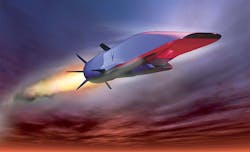LIFT Taps 3DP, NDT Firms for Hypersonics R&D
The LIFT manufacturing research institute awarded a “hypersonics challenge” project to evaluate and demonstrate the industrial maturity for process monitoring methods for several additive manufacturing technologies under consideration for hypersonic metallic structures. LIFT member companies Velo3D Inc. and Vibrant Corp., and the University of Arizona, will evaluate laser powder-bed fusion additive manufacturing, rapid post-build non-destructive inspection, and defect detection for flight-qualified hypersonic metallic structural applications.
Last year LIFT and the DOD introduced the Hypersonics Challenge, a program led by Lockheed Martin and seeking proposals on topics critical to the materials science and manufacturing processes of hypersonic vehicles.
LIFT is the Detroit-based the Lightweight Innovations for Tomorrow, a research center established in 2014 to coordinate academic and industrial research into lightweight mobility technologies. It is operated by the American Lightweight Materials Manufacturing Innovation Institute, and partly funded by the Dept. of Defense and managed through the Office of Naval Research.
Velo3D is a supplier of powder-bed, metal additive manufacturing technology for complex parts in aerospace, other transportation systems, and oil-and-gas applications.
Vibrant Corp. offers “process compensated resonance testing” (PCRT) services for aerospace, automotive, and power-generation manufacturing, as well as materials laboratories with nondestructive testing.
“There are gaps which exist in the in-situ process monitoring, non-destructive inspection, and data analytics to ensure components are being produced reliably and repeatably,” stated Christina Bain, senior manager, Hypersonics and Advanced Materials Directorate, Lockheed Martin Space. “With this project, we will address those gaps by leveraging existing best-in-class capabilities, which exist at the original equipment manufacturer level and are ripe from broader use.”
Lockheed is known to be developing high-speed systems for combating high-value targets quickly from hundreds or even thousands of miles away – so-called, hypersonic weapons. Hypersonic systems operate at speeds of Mach 5 or higher and are among DOD’s top developmental priorities, along with establishing secure domestic supply base.
Last May Lockheed along with Northrop Grumman conducted a live-fire hypersonic strike test system, and in October the company announced a new manufacturing plant for hypersonic missile systems in Courtland, Ala.
In December, LIFT awarded a research project to ATC Materials Inc., The Ohio State University, and the University of Dayton, to demonstrate reliable production of RIPS molded radio-frequency (RF) material. As-molded and molded-machined components will be manufactured and tested, to determine the validity of net-shape molding of the material that is eyed for hypersonic sensors and seekers.
